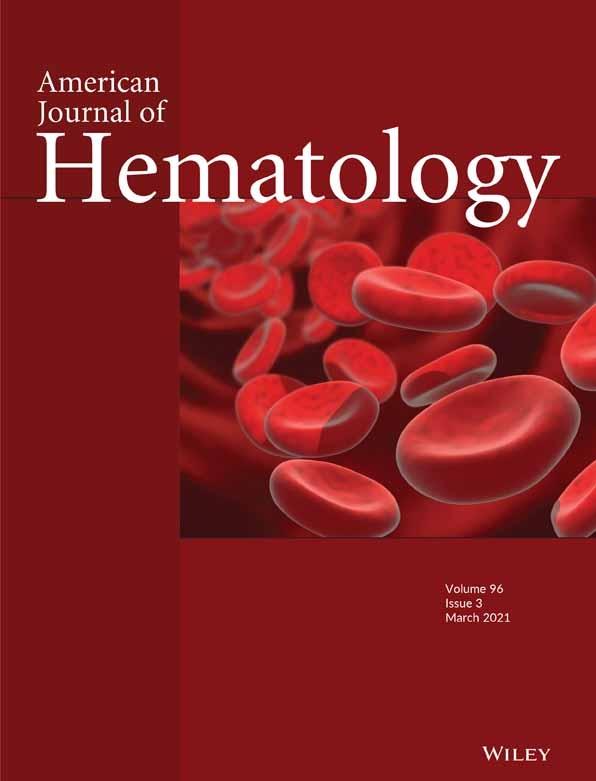
Hematologic findings in a large sample of patients with anorexia nervosa and bulimia nervosa
Walsh K, Blalock D., Mehler PS. Hematologic findings in a large sample of patients with anorexia nervosa and bulimia nervosa. Amer J of Hematology. 2020.
Patients with anorexia nervosa (AN) and bulimia nervosa (BN) suffer from many medical complications as a result of their eating disorders. The Diagnostic and Statistical Manual of Mental Disorders Fourth Edition (DSM‐ IV) defines AN as an eating disorder in which individuals refuse to maintain a minimally normal body weight and an intense fear of gaining weight.1 In the restricting subtype (AN‐R), weight loss is from markedly restricting dietary intake. In the binge‐eating/purging subtype (AN‐B/P), in addition to restricting intake, the patient engages in purging behaviors which can include self‐induced vomiting or the misuse of laxatives. Bulimia nervosa is diagnosed when a patient is having recurrent episodes of binge eating and then uses an inappropriate compensatory behavior to prevent weight gain.1 Anorexia nervosa is associated with a high mortality rate of 5.6% per decade.2
Sabel described the prevalence of hematologic abnormalities in a limited sample of 53 extremely medically ill patients with AN,3 and many years ago Miller described their prevalence in 214 AN outpatients.4 But, there has not been a large study of adult residential patients from a typical eating disorder program. We retrospectively reviewed hematologic data, as part of the largest medical study to date, of residential status patients with AN and BN from an eating disorder program. The purpose was to inform the evaluations of these patients should they access care via a hematologic consultation while hospitalized in medical facilities. A multidisciplinary team of physicians, licensed dietitians, therapists, and registered nurses made an initial diagnosis of AN‐R, AN‐B/P, or BN. Since the “Feeding and Eating Disorders” chapter of the Diagnostic and Statistical Manual of Mental Disorders, Fifth Edition (DSM‐5), which was released in 2013, features modifications of the DSM‐IV, we based our diagnoses on the DSM‐IV criteria since data collection started in 2012. An institutional review board granted approval for the study.
Demographic information, clinical data, and medical history were extracted retrospectively from patient medical records for adult residential admissions to the Eating Recovery Center (ERC) in Denver, Colorado, between January 2012 and 2015. The sample consisted of 921 patients and was stratified by sub‐types of AN‐R, AN‐B/P, or BN.
Routine laboratory values, from the time of admission were used to detect these conditions: anemia (hematocrit <37%), thrombocytopenia (platelets <150 K/μL), leukopenia (white blood cell count <4.5 K/μL), macrocytosis (mean corpuscular volume [MCV] >100 fL), and microcytosis (MCV <80 fL). Weight in pounds was determined upon admission. Inferential statistics were calculated using chi‐square, t test, pearson correlation, ANOVA, and Tukey's HSD.
Patients' diagnoses were mixed (AN‐R = 415; AN‐B/P = 383; BN = 123). Patients were mostly female (93.6%) and Caucasian (93.2%). Average age was 28.3 years (SD = 10.2). Average duration of patients' eating disorders was 11.3 years (SD = 9.1). Admission BMI of patients was 17.4 (SD = 3.7), with AN patients having a lower admission BMI (15.5) and BN patients having a higher admission BMI (20.8). For the AN‐B/P patients, 79.5% engaged in self‐induced vomiting, 38.4% abused laxatives, and 8% abused diuretics.
Table 1 illustrates hematologic values and abnormalities, divided by eating disorder subtype. Significant differences in hematologic values by eating disorder subtype are also noted in the Table.
Table 1. Hematologic findings across eating disorder diagnoses
| Total sample (N = 921) | AN‐R (N = 415) | AN‐B/P (N = 383) | BN (N = 123) | |
|---|---|---|---|---|
| Hematocrit % (SD) | 40.6 (4.1) | 40.9 (4.2) | 40.3 (4.2) | 40.8 (3.0) |
| Anemia (%) | 17.2% | 16.4% | 20.2% | 11.2% |
| MCV fL (SD) | 91.6 (6.8) | 92.6 (6.3)a | 90.9 (7.0)b | 90.1 (7.1)b |
| Microcytosis (%) | 2.4% | 1.3% | 3.8% | 1.7% |
| Macrocytosis (%) | 5.9% | 6.9% | 5.8% | 2.6% |
| Platelets K/μL (SD) | 255.5 (77.5) | 242.5 (69.4)a | 263.8 (83.9)b | 274.9 (76.7)b |
| Thrombocytopenia (%) | 5.8% | 7.4% | 5.2% | 1.7% |
| White blood cell count K/μL (SD) | 5.3 (2.1) | 4.9 (2.0)a | 5.5 (2.2)b | 6.3 (2.0)c |
| Leukopenia (%) | 40.4% | 50.5%a | 36.8%b | 17.2%c |
- Note: abc Use of different letters within the same variable row represent significant differences in means at least at the P < .05 level following Tukey's HSD posthoc test with multiple comparison corrections.
Anemia was present in 16.4% of patients with AN‐R, 20.2% of patients with AN‐B/P, and 11.2% of patients with BN. Microcytosis was only present in 1.3% of those with AN‐R, 3.8% of those with AN‐B/P, and 1.7% of those with BN. However, among anemic patients, microcytosis was present in significantly fewer patients with AN‐R (1.6%) than patients with AN‐B/P (8.8%; P < .01) or patients with BN (7.7%; P < .01). The average MCV in patients with microcytosis was 68.4 fL. Macrocytosis was present in 6.9% of those with AN‐R, 5.8% of those with AN‐B/P, and 2.6% of those with BN. However, among anemic patients, macrocytosis was present in significantly more patients with AN‐R (20.3%) than patients with AN‐B/P (10.3%; P < .01) or patients with BN (7.7%; P < .01). The average MCV in patients with macrocytosis was 103.7 fL. Average MCV for the entire study population was 91.6 fL (SD = 6.8). Patients with AN‐R (92.6) had significantly higher MCV than patients with AN‐B/P (90.9; P = .001) or patients with BN (90.1; P = .001). Serum iron levels were not routinely ordered on admission.
Thrombocytopenia was found in 7.4% of those with AN‐R, 5.2% of those with AN‐B/P, and 1.7% of those with BN. The average platelet count in those with thrombocytopenia was 127 000 per μL. Prevalence of thrombocytopenia was not significantly different by eating disorder subtypes (P = .06).
Leukopenia was present more often in patients with AN‐R (50.5%) than patients with AN‐B/P (36.8%; P < .001). Both subtypes of patients with AN presented with leukopenia more often than patients with BN (17.2%; probabilities < .001). Low white blood cell count (WBC) was moderately correlated with BMI (r = .31, P < .001). Thus, for patients who were < 70% IBW (BMI < 14), 33% were leukopenic, and for patients with %IBW > 80%, only 7% were leukopenic (χ2 = 80.4, P < .001). The average WBC was higher among patients with BN (6.3 k/μL, SD = 2.0) than among patients with AN‐R (4.9 k/μL, P < .001) or AN‐B/P patients (5.2 k/μL, P < .001). Patients with AN‐B/P also had a significantly higher WBC count than patients with AN‐R (P < .01). However, WBC count was not associated with serum levels of prealbumin, phosphorus, 25‐OH vitamin D, liver function tests, nor the presence of bradycardia, osteoporosis, or duration of illness.
This study is the largest ever in the literature which singularly investigated the hematologic findings in patients with AN and BN. Our study revealed many unique hematologic findings which varied by severity and by type of eating disorder. Thus, microcytosis was only rarely noted in the study population and was not different across type of eating disorder. Therefore, when consulting on a patient with an eating disorder who has a microcytic anemia, it is not likely to be solely attributable to the eating disorder per se. Rather, it should be evaluated within the differential diagnosis of microcytosis as opposed to summarily attributing it to malnutrition. Iron deficiency anemia is not a typical finding in patients with AN, due to the frequent co‐occurrence of secondary amenorrhea.
However, macrocytosis was much more frequently seen with a prevalence of 6.9% in AN‐R, 5.8% in AN‐B/P, and 2.6% in BN. It is interesting to note that every patient with AN who had macrocytosis, was also anemic. We only routinely collect admission vitamin B12 and folic acid levels when the MCV is >110, because aside from low vitamin D levels, most other micronutrient and vitamin levels are normal in AN.
One wonders if those with purging behaviors are more likely to have associated blood loss, either due to blood lost in vomitus or stool, but this appears to not be the case since our AN‐R and AN‐B/P patients had a similar likelihood of anemia (16.3% vs 20.2%, P = 0.40). Our findings are consistent with those of Abella who concluded that the extent of bone marrow change is related to amount of weight loss.5
Thrombocytopenia was noted to be the least frequent abnormal finding of the complete blood cell counts (CBC). Thus, when present as an isolated CBC finding in AN, a low platelet count would seem to merit further evaluation.
The white blood cell counts were the most frequently low of the three blood cell lines. This is likely due to some degree of the gelatinous marrow transformation, which is of unknown etiology. However, the serous fat atrophy is likely reflective of the overall loss of fat from malnutrition. It has been previously noted that the extent of bone marrow damage and trilinear hypoplasia is best correlated with the amount of weight loss.4 However, notwithstanding their leukopenia, the overall rate of infection is surprisingly not increased in AN.
The extent of hematologic abnormalities in AN depends on the severity of caloric deprivation, such that resumption of intake and weight gain are generally all that is needed for both serum and marrow abnormalities to normalize. There is generally no role for extensive hematologic work ups with bone marrow biopsies for leukopenia, or for the use of costly growth factors such as granulocyte stimulating factor, since leukopenia resolves with weight gain over the course of just a few weeks or months. Ultimately, all hematologic and morphological alterations disappear completely and rapidly after sufficient refeeding.6 Presumably, since patients with BN are of normal body weight, abnormalities in the CBC are much more frequent in the patients with AN. The relatively small percentages of hematologic changes in patients with BN are likely attributable to the known poor eating habits in these patients.
In summary, this study represents the largest study ever published on the hematologic findings in patients with eating disorders. Overall, while there are many different abnormalities present in the CBCs of this patient population, they appear to be mostly a direct result of malnutrition. Thus, a message of diagnostic restraint is a thematic cord when being asked to consult on the CBC aberrations of a patient with AN, and a strategy of conservative observation seems mostly justified while weight is being restored to normal.
CONFLICT OF INTEREST
All authors declare no conflict of interest.


